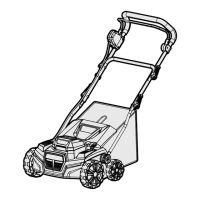OPERATION
OVERLOAD PROTECTION
Your machine is equipped with overload protection and will activate in the following circumstances:
a. If there is a build-up of scarified materials around the cutting device.
b. If the scarified materials are larger than the motor capacity.
c. If there is too much resistance against the cutting device.
If the circuit breaker has been activated, switch the machine OFF and remove from the power source. Let the de-
thatcher / scarifier cool down while determining the issue. Remove build-up or large materials before continuing
operation.
SCARIFYING
Scarifying is more intense than dethatching. The blades reach down deep to remove moss, fungus, thatch, and other
unwanted buildup from your lawn, while leaving the grass intact. At the same time, it scarifies (cuts grooves into)
the ground, resulting in better drainage aeration for your lawn and, overall, better growth. Increase the depth setting
in spring (April - May). The lawn is actively growing and will recover much better during this season. If the summer
is wet, scarify again in late summer or early fall, using a decreased depth setting. Do not scarify during periods of
hot, dry weather. If the summer is very dry, do not scarify again in fall.
RAKING / DETHATCHING
Dethatching is less intense than scarifying, and does just what it sounds like - the steel tines reach down to pick up
thatch and other light debris, resulting in better aeration and drainage. When to dethatch varies; if your lawn is prone
to thatch buildup (especially if you use a mulch setting on your lawn mower, or have certain species of grass), you'll
need to dethatch more often. Choose a time when the grass is actively growing, and the soil has some moisture. In
the northern half of the US, this will usually be in the early spring or early fall. For the southern half of the US, this
will usually be in late spring through early summer.
16

